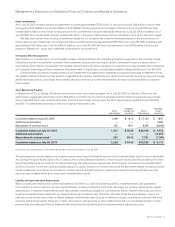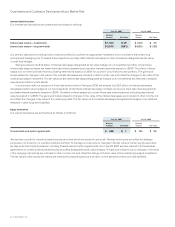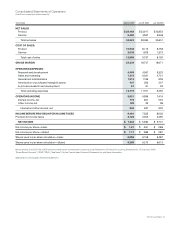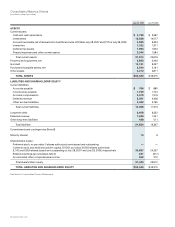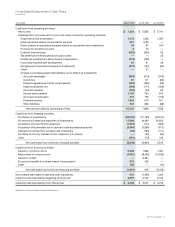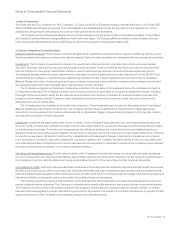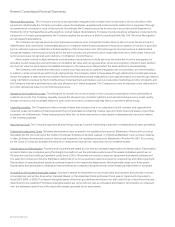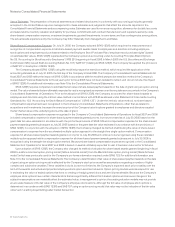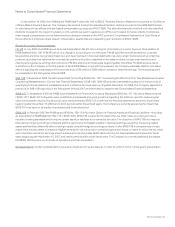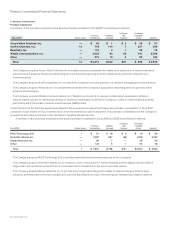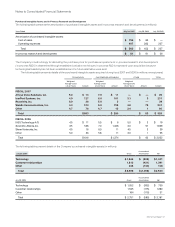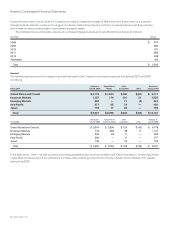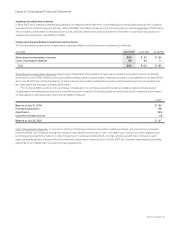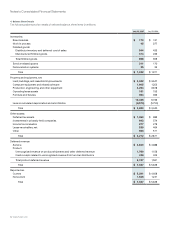Cisco 2007 Annual Report Download - page 47
Download and view the complete annual report
Please find page 47 of the 2007 Cisco annual report below. You can navigate through the pages in the report by either clicking on the pages listed below, or by using the keyword search tool below to find specific information within the annual report.
50 Cisco Systems, Inc.
Notes to Consolidated Financial Statements
Revenue Recognition The Company’s products are generally integrated with software that is essential to the functionality of the
equipment. Additionally, the Company provides unspecified software upgrades and enhancements related to the equipment through
its maintenance contracts for most of its products. Accordingly, the Company accounts for revenue in accordance with Statement of
Position No. 97-2, “Software Revenue Recognition,” and all related interpretations. For sales of products where software is incidental to the
equipment, or in hosting arrangements, the Company applies the provisions of Staff Accounting Bulletin No. 104, “Revenue Recognition,”
and all related interpretations.
The Company recognizes revenue when persuasive evidence of an arrangement exists, delivery has occurred, the fee is fixed or
determinable, and collectibility is reasonably assured. In instances where final acceptance of the product, system, or solution is specified
by the customer, revenue is deferred until all acceptance criteria have been met. Technical support services revenue is deferred and
recognized ratably over the period during which the services are to be performed, which is typically from one to three years. Advanced
services revenue is recognized upon delivery or completion of performance.
When a sale involves multiple elements, such as sales of products that include services, the entire fee from the arrangement is
allocated to each respective element based on its relative fair value and recognized when revenue recognition criteria for each element
are met. Fair value for each element is established based on the sales price charged when the same element is sold separately.
The Company uses distributors that stock inventory and typically sell to systems integrators, service providers, and other resellers.
In addition, certain products are sold through retail partners. The Company refers to these sales through distributors and retail partners as
its two-tier system of sales to the end customer. Revenue from distributors and retail partners is recognized based on a sell-through method
using information provided by them. Distributors and retail partners participate in various cooperative marketing and other programs, and
the Company maintains estimated accruals and allowances for these programs. The Company accrues for warranty costs, sales returns,
and other allowances based on its historical experience.
Allowance for Doubtful Accounts The allowance for doubtful accounts is based on the Company’s assessment of the collectibility of
customer accounts. The Company regularly reviews the allowance by considering factors such as historical experience, credit quality,
the age of the accounts receivable balances, and current economic conditions that may affect a customer’s ability to pay.
Lease Receivables The Company provides a variety of lease financing services to its customers to build, maintain, and upgrade their
networks. Lease receivables primarily represent the principal balance remaining in sales-type and direct-financing leases under these
programs, net of allowances. These leases typically have two- to three-year terms and are usually collateralized by a security interest
in the underlying assets.
Advertising Costs The Company expenses all advertising costs as incurred. Advertising costs were not material for all years presented.
Software Development Costs Software development costs required to be capitalized pursuant to Statement of Financial Accounting
Standards No. 86, “Accounting for the Costs of Computer Software to Be Sold, Leased, or Otherwise Marketed,” have not been material
to date. Software development costs for internal use required to be capitalized pursuant to Statement of Position No. 98-1, “Accounting
for the Costs of Computer Software Developed or Obtained for Internal Use,” have also not been material to date.
Depreciation and Amortization Property and equipment are stated at cost, less accumulated depreciation and amortization. Depreciation
and amortization are computed using the straight-line method over the estimated useful lives of the assets. Estimated useful lives of
25 years are used for buildings. Estimated useful lives of 30 to 36 months are used for computer equipment and related software and
five years for furniture and fixtures. Estimated useful lives of up to five years are used for production, engineering, and other equipment.
Depreciation of operating lease assets is computed based on the respective lease terms, which generally range up to three years.
Depreciation and amortization of leasehold improvements are computed using the shorter of the remaining lease terms or five years.
Goodwill and Purchased Intangible Assets Goodwill is tested for impairment on an annual basis and between annual tests in certain
circumstances, and written down when impaired. Based on the impairment tests performed, there was no impairment of goodwill in
fiscal 2007, 2006, or 2005. Purchased intangible assets other than goodwill are amortized over their useful lives unless these lives are
determined to be indefinite. Purchased intangible assets are carried at cost, less accumulated amortization. Amortization is computed
over the estimated useful lives of the respective assets, generally two to seven years.



